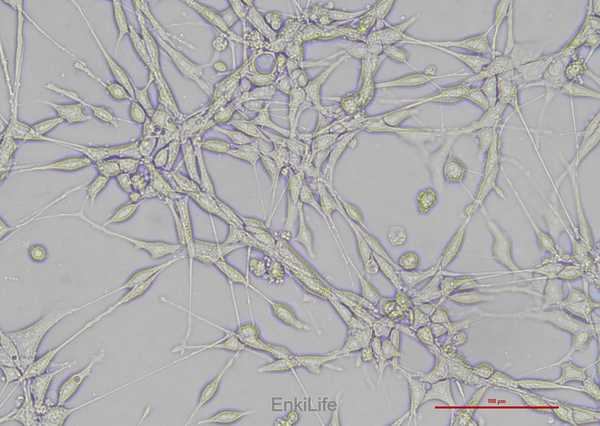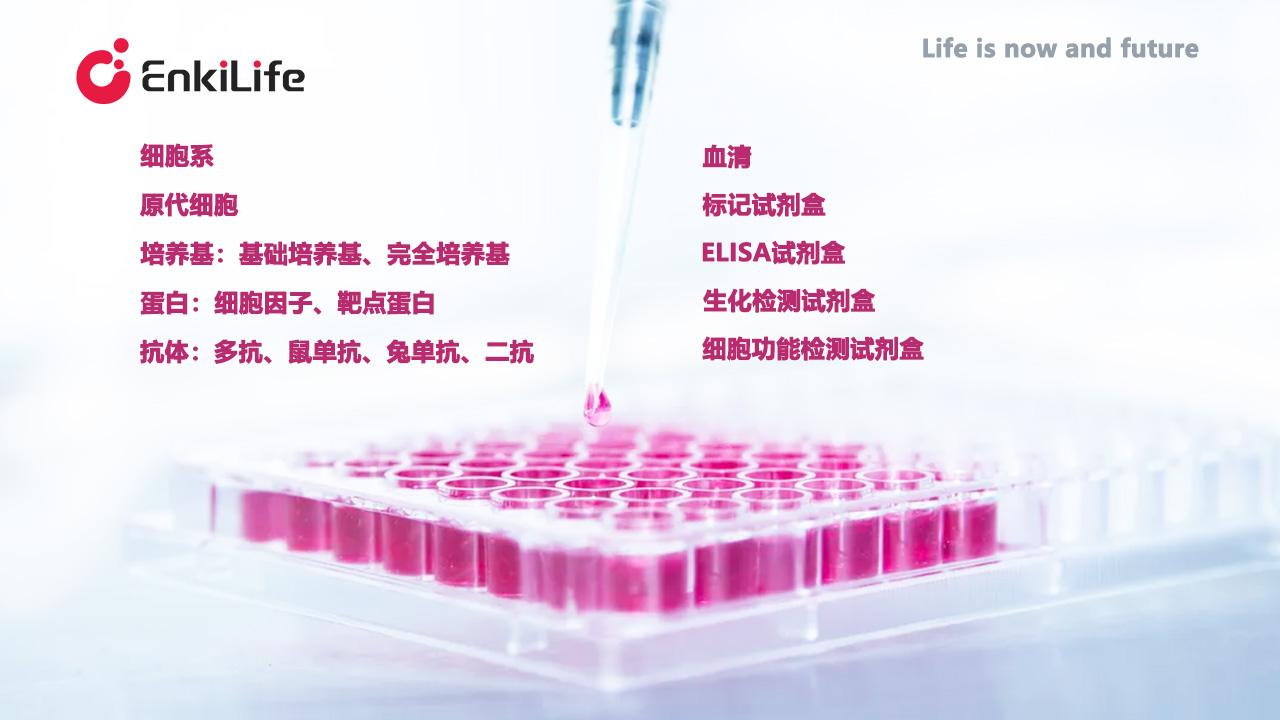小鼠結(jié)腸癌細(xì)胞CT26.WT
一���、細(xì)胞起源
1.起源:CT26.WT源于BALB/c小鼠經(jīng)化學(xué)致癌劑N-亞硝基-N-甲基尿烷(NMU)誘導(dǎo)的未分化結(jié)腸腺癌�����,具有高度侵襲性和轉(zhuǎn)移特性[1]�。
2.遺傳背景:攜帶突變型KRAS基因和野生型p53,模擬了人類結(jié)腸癌的常見遺傳變異[1]����。

二、生物學(xué)特性
1.增殖與代謝:
- 高增殖速率��,體外倍增時間約12–16小時[1]�。
- 能量代謝依賴糖酵解和氧化磷酸化,抗增殖藥物組合(OLD)可顯著抑制其代謝靈活性[2]��。
2.免疫逃逸機(jī)制:
- 高表達(dá)PD-L1���,受IFN-γ調(diào)控,參與免疫檢查點逃逸[3]���。
- HMGB1過表達(dá)通過激活自噬(PI3KIII/Beclin-1通路)抵抗樹突狀細(xì)胞(DCs)誘導(dǎo)的凋亡[4]�。
3.轉(zhuǎn)移特性:
- 高表達(dá) 基質(zhì)金屬蛋白酶(MMP-2/9) 和MD2蛋白����,促進(jìn)遷移與肺轉(zhuǎn)移[5]�����。
- S1P/S1PR2軸通過下調(diào)MHC-II表達(dá)抑制CD4?T細(xì)胞免疫監(jiān)視[6]���。
三、培養(yǎng)與儲存
1.培養(yǎng)基: RPMI 1640 + 10%胎牛血清(FBS) ��,CO?濃度5.0%[1][7]���。
2.傳代比例:1:3–1:5��,每周2–3次�����。
3.凍存方法:90% FBS + 10% DMSO�����,液氮長期保存��。
四��、研究應(yīng)用領(lǐng)域
1.腫瘤免疫治療:
- 作為免疫治療模型�,用于評估PD-1/PD-L1抑制劑(如Aikejia聯(lián)合療法)[3]。
- 重組禽痘病毒(rFPV)遞送腫瘤抗原可激活CD8?T細(xì)胞殺傷[8]��。
2.藥物篩選:
- 黃酮衍生物L(fēng)2H17通過抑制NF-κB/PI3K-Akt通路誘導(dǎo)凋亡[9]��。
- OLD組合(奧利司他+洛尼達(dá)胺+DON)抑制能量代謝并促進(jìn)凋亡[2]���。
3. 腫瘤微環(huán)境研究:
- 瘧原蟲感染通過破壞線粒體生物合成(抑制PGC-1α)抑制增殖并促進(jìn)凋亡[10]����。
五��、近五年研究進(jìn)展(2020–2025)
1. 新型免疫療法:
- TS-L6(抗體-拓?fù)洚悩?gòu)酶I抑制劑偶聯(lián)物) 可誘導(dǎo)長期免疫記憶��,100%排斥HER2?腫瘤再挑戰(zhàn)[11]���。
2. 代謝靶向治療:
- OLD組合使細(xì)胞代謝表型向"靜止態(tài)"轉(zhuǎn)變�����,限制葡萄糖/谷氨酰胺利用[2]。
3. 天然產(chǎn)物抗腫瘤:
- 藥用蘑菇提取物AGARIKON通過調(diào)節(jié)巨噬細(xì)胞極化(M1/M2)和抑制VEGF發(fā)揮抗血管生成作用[12]���。
- 唇形科植物精油(如L. sidoides)選擇性殺傷CT26.WT(IC??=19.06 μg/mL)[13]����。
六、局限性及克服策略
1.局限性:
- 免疫異質(zhì)性:缺乏人類免疫系統(tǒng)復(fù)雜性����,限制了免疫治療轉(zhuǎn)化[3]。
- 藥物遞送效率低:內(nèi)吞途徑pH值偏低(pH<5.0)���,影響納米載體遞送效率[7]����。
2.克服策略:
- 人源化小鼠模型:移植人源免疫細(xì)胞提升臨床相關(guān)性[4]����。
- 新型遞送系統(tǒng):FN多肽修飾的PEG化脂質(zhì)體可靶向α5β1整合素提升攝取[14]。
七��、總結(jié)與展望
CT26.WT作為經(jīng)典的未分化結(jié)腸癌模型����,在免疫治療機(jī)制、代謝重編程和藥物開發(fā)中不可或缺�。未來需結(jié)合類器官共培養(yǎng)�、單細(xì)胞測序等技術(shù)解析腫瘤異質(zhì)性���,并開發(fā)雙特異性抗體及代謝-免疫聯(lián)合療法以突破當(dāng)前治療瓶頸�����。

參考文獻(xiàn)
1. Targeting Hsp90 with NW457 radiosensitizes tumor cells. Linda A, et al. PLoS One. 2014;9(2):e89150.
2. The combination of orlistat, lonidamine and 6-diazo-5-oxo-L-norleucine induces a quiescent energetic phenotype in colon cancer cells. Schcolnik-Cabrera A, et al. Sci Rep. 2020;10(1):11163.
3. Immunopotentiator Aikejia improves the therapeutic efficacy of PD-1/PD-L1 blockade in CT26.WT cancer cells. Huang C, et al. Front Immunol. 2019;10:1285.
4. HMGB1 promotes autophagy-mediated survival in colon cancer co-cultured with dendritic cells. Zheng Y, et al. Oncol Rep. 2018;39(3):1247-1259.
5. Selective targeting of the TLR4 co-receptor, MD2, prevents colon cancer growth and lung metastasis. Rajamanickam V, et al. Int J Biol Sci. 2020 Feb 17;16(8):1288-1302. [PMID: 32210720]
6. The Sphingosine-1-Phosphate/Sphingosine-1-Phosphate Receptor 2 Axis in Intestinal Epithelial Cells Regulates Intestinal Barrier Function During Intestinal Epithelial Cells-CD4+T-Cell Interactions. Chen T, et al. Cell Physiol Biochem. 2018;48(3):1188-1200. [PMID: 30045015]
7. Endocytic Profiling of Cancer Cell Models Reveals Critical Factors Influencing LNP-Mediated mRNA Delivery and Protein Expression. Sayers EJ, et al. Mol Ther. 2019 Nov 6;27(11):1950-1962. [PMID: 31427168]
8. Active immunotherapy of cancer with a nonreplicating recombinant fowlpox virus encoding a model tumor-associated antigen. Wang M, et al. J Immunol. 1995 May 1;154(9):4685-92. [PMID: 7722321]
9. Chemopreventive effect of chalcone derivative, L2H17, in colon cancer development. Xu S, et al. Sci Rep. 2015;5:16144. [PMID: 2655?3361]
10. Plasmodium infection suppresses colon cancer growth via disrupting mitochondrial biogenesis. Yao X, et al. Cell Death Dis. 2022;13:34. [PMID: 350?13129]
11. A HER2-targeted antibody-novel DNA topoisomerase I inhibitor conjugate induces durable adaptive antitumor immunity by activating dendritic cells. Tan X, et al. MAbs. 2023 Jan-Dec;15(1):2220466. [PMID: 37314961]
12. Antitumor, Immunomodulatory and Antiangiogenic Efficacy of Medicinal Mushroom Extract Mixtures in Advanced Colorectal Cancer Animal Model. Jakopovic B, et al. Molecules. 2020 Oct 28;25(21):5005. [PMID: 33126765]
13. Targeting colon cancer with fibronectin-mimetic peptide liposomes. Garg A, et al. Langmuir. 2008;24(20):11836-410. [PMID: 1877803?1]
14. Active immunotherapy of cancer with a nonreplicating recombinant fowlpox virus encoding a model tumor-associated antigen. Wang M, et al. J Immunol. 1995;154(9):4685-92. [PMID: 75?37761]